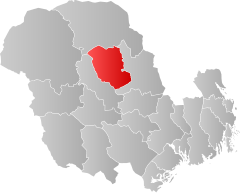Hjartdal
| coat of arms | map | |
|---|---|---|

|
|
|
| Basic data | ||
| Commune number : | 3819 | |
| Province (county) : | Vestfold and Telemark | |
| Administrative headquarters: | Sauland | |
| Coordinates : | 59 ° 40 ′ N , 8 ° 44 ′ E | |
| Surface: | 791.61 km² | |
| Residents: | 1,573 (Feb 27, 2020) | |
| Population density : | 2 inhabitants per km² | |
| Language form : | Nynorsk | |
| Website: | ||
| politics | ||
| Mayor : | Bengt Halvard Odden ( Ap ) (2015) | |
| Located in the province of Vestfold og Telemark | ||

|
||
Hjartdal is a Norwegian municipality in the Telemark region in Fylke Vestfold og Telemark with 1573 inhabitants (as of February 27, 2020). The seat of the administration is in the locality Sauland .
geography
The Hjartdøla River flows through Hjartdal Municipality . Highest elevation in the Gaustaråen with 1614.7 moh. , which lies on the border with the neighboring municipality of Tinn . The Sauland administrative center is located in the south-east of the municipality in a valley area. Agriculture and forestry can be carried out there. In the entire municipality there is no so-called Tettsted , i.e. a settlement that is recorded as a larger town for statistical purposes. The largest settlements in Hjartdal are the valley village of Sauland and the mountain villages of Hjartdal and Tuddal.
The European route 134, also known as Haukelivegen , runs through the southern part of the municipality and connects the cities of Drammen and Haugesund . The road leads to 1260 moh. over a pass and is closed for passage in this area in winter.
The official form of language in Hjartdal is Nynorsk , which is the rarer of the two Norwegian written languages.
history
Until the regional reform in Norway , which was completed on January 1, 2020, Hjartdal was part of Fylke Telemark . As part of the reform, this was transferred to the newly created province of Vestfold og Telemark .
economy
In Sauland, the climatic and geographical conditions are suitable for agriculture. In 2018 around 30 percent of jobs in the municipality were in the agriculture and forestry sector, making Hjartdal the municipality with the highest proportion in this area. Tourism plays a bigger role in the mountain village of Tuddal in particular , as there are many holiday huts there.
There are six power plants in Hjartdal , which had an average annual production of 466 gigawatt hours in 2016. The largest of the six plants is the Hjartdøla Kraftverk hydropower plant , which has been in operation since 1958.
Culture and sights
There is an above-average number of older and protected buildings in the municipality. In Frøland near Sauland there is a building from the late Middle Ages and in Øvre Åbø and Søndre Bøen there is a building from the 13th century each. Hjartdal Church was built in 1809. The entrance to Sauland Stave Church, which was demolished in 1860, is exhibited in the Kulturhistorisk Museum in Oslo . The Tuddal Bygdetun open-air museum is located in Tuddal and comprises 15 old houses.
In 2007 the municipality was awarded the first national cultural landscape award by the Norwegian cultural heritage organization Norsk Kulturarv . In 1994 the areas of Hjartdal Nodbygd and Svartdal were designated as cultural landscape areas.
The priest Magnus Brostrup Landstad made the legends about Hjartdal known in his folk songs. The painters Adolph Tidemand , Hans Fredrik Gude , Harald Kihle and Henrik Sørensen visited Hjartdal several times.
Coat of arms and name
The municipality's official coat of arms since 1989 shows a silver deer on a green background. It represents the deer population of the municipality. The name Hjartdal probably derives from Hjart , in modern Norwegian Hjort , which means deer. The people of Hjartdal are known as Hjartdøl.
Web links
- Hjartdal in the store norske leksikon (Norwegian)
- Facts about Hjartdal at Statistisk sentralbyrå (Norwegian)
Individual evidence
- ↑ Statistisk sentralbyrå - Befolkning
- ↑ Høyeste fjelltopp i hver commune. Kartverket, September 1, 2015, accessed February 25, 2020 (Norwegian Bokmål).
- ↑ E134 Gvammen-Århus. Statens Vegvesen, accessed on February 25, 2020 (Norwegian Bokmål).
- ↑ Forskrift om målvedtak i kommunar and fylkeskommunar (målvedtaksforskrifta) - Lovdata. Retrieved February 25, 2020 .
- ↑ Histories om Tuddal. In: Velkommen til Tuddal. Retrieved February 25, 2020 .
- ↑ Hjartdøla - Skagerak Force. Retrieved February 25, 2020 (Norwegian).
- ↑ Tuddal bygdetun. In: Velkommen til Tuddal. Retrieved February 25, 2020 .
- ↑ Den nasjonale kulturlandskapsprisen 2019. Norsk Kulturarv, September 3, 2019, accessed on February 25, 2020 (Norwegian Bokmål).
- ↑ Innbyggjarnamn. Språkrådet, accessed on February 25, 2020 (Norwegian Nynorsk).
